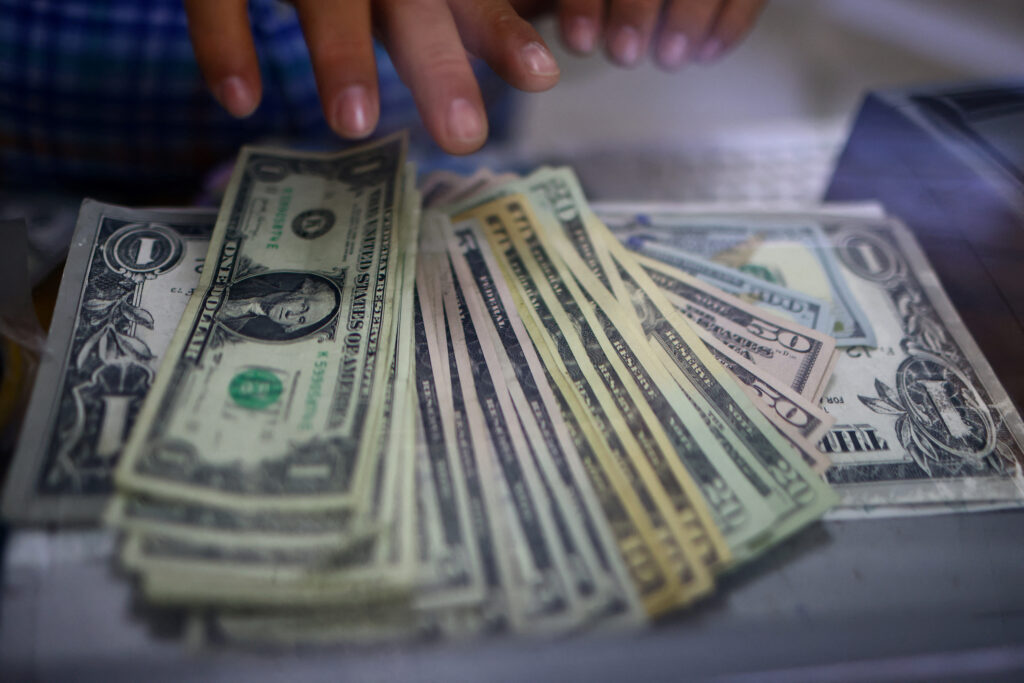
By Amanda Cooper
LONDON (Reuters) – The dollar retreated on Wednesday after data showed the Chinese economy slipped into deflation last month, which upped the chances for the government to roll out extra stimulus measures and nudged investors into risk assets.
Dollar selling by state-owned Chinese banks helped the yuan rally off a one-month low even as the country slipped into deflation, dealers said. The Chinese central bank’s stronger-than-expected exchange-rate fixing at 7.1588 per dollar before the open signalled its discomfort with the yuan’s recent declines.
The dollar index – which measures the U.S. currency against the euro, sterling and four other others – eased 0.22% to 102.29, paring some of the 0.47% rise the previous session.
The euro rose 0.3% to $1.09865, while sterling rose 0.16% to $1.27695. European markets gained some respite after equities tumbled the day before after the Italian government announced a surprise 40% windfall tax on banks. The finance ministry subsequently softened its stance, but the initial decision stripped 3.5% off major eurozone lenders’ shares.
ALSO READ: Dollar gains after steep losses, but downtrend stays intact
Data on Wednesday showed Chinese consumer prices fell for the first time in more than two years in July. Rather than lifting the safe-haven appetite for the dollar, the figures reinforced the view among some investors that the Chinese government might take steps to underpin the economy with monetary stimulus.
“There are still no signs yet from officialdom of imminent support” for the Chinese economy, despite the “protest of sorts against the recent run-up in the dollar-yuan rate” implicit in the strong yuan fixing, said Ray Attrill, head of foreign-exchange strategy at National Australia Bank.
As a result, the dollar index will stay “pretty well supported” above 102, although 103 is the likely near-term ceiling, Attrill said.
The Aussie added 0.13% to $0.6553, after dipping on Tuesday to the lowest since June 1 at $0.6497.
New Zealand’s kiwi rose 0.16% to $0.6074, rebounding from the previous session’s two-month low of $0.6035.
U.S. inflation data is due Thursday and looms large over a market hungry for clues on the path for Federal Reserve policy and, for now, this is likely to carry more weight for investors than a retreat in price pressures in China, according to Daiwa Capital Markets head of economic research Chris Scicluna.
ALSO READ: Dollar steady ahead of jobs data, yen shines after Japan wage data
“Really, the central bankers, whether it’s the Fed, or the ECB or the Bank of England, are concerned about services prices and also about the overall tightness of the labour markets and that’s not going to change because of what is going on in China,” he said.
There were more dovish signals from Fed officials overnight, with Philadelphia Fed President Patrick Harker suggesting interest rates are high enough already, echoing the view of Atlanta Fed President Raphael Bostic.
The message has been far from uniform though, with Fed Governor Michelle Bowman saying on Monday that further hikes are likely.
Money market traders still heavily favour a quarter-point rate increase at the next policy meeting in September, laying odds of 86.5%.




